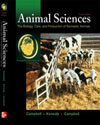
Fundamental Principles of Genetics |  |
Chapter Summary| Cells are the building blocks of which the body is made, and each individual possesses trillions of them. The main parts of the cell include the nucleus and cytoplasm. The nucleus is the heart and brain of the cell and contains the chromosomes. Each species of animal possesses the characteristic number of chromosomes for that species. Chromosomal abnormalities sometimes occur and usually result in an abnormal phenotype or death of the individual. Chromosomal abnormalities include variations from normal in structure and numbers.
Genes, the determiners of heredity, are carried on chromosomes. The gene is a portion of a DNA molecule and has the ability to replicate itself when new cells are formed. It also sends the code for protein structure and synthesis to ribosomes in the cytoplasm by means of messenger RNA. The genetic code and protein synthesis are complex, and functions of the gene in protein synthesis are a recent discovery.
Genes may express themselves in the phenotype in two general ways, known as additive and nonadditive phenotypic expressions. Genes also segregate into the gametes (sperm and ovum) and recombine in the zygote (the new individual resulting from the union of a sperm and an ovum) according to certain laws of probability.
A promising field of scientific endeavor is genetic engineering. The ability to locate genes on chromosomes, transfer them between animals within and among species, and clone individual animals with characteristics that have value is blossoming. This will provide many opportunities to assist in disease recognition and treatment in humans and in the development of animals that can provide important benefits to humanity.
|
|
|